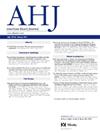Exploration of the regional effects of colchicine in the LoDoCo2 trial
IF 3.7
2区 医学
Q1 CARDIAC & CARDIOVASCULAR SYSTEMS
引用次数: 0
Abstract
Background
The Low Dose Colchicine 2 (LoDoCo2) trial randomized 5,522 patients with chronic coronary disease to colchicine 0.5mg daily or placebo in a 1:1 ratio and demonstrated the cardiovascular benefits of colchicine. In the trial, which was conducted in Australia and The Netherlands, a prespecified subgroup analysis suggested a difference in magnitude of treatment effect of colchicine by region (Australia: HR 0.51; 95% CI 0.39-0.67 vs The Netherlands: HR 0.92; 95% CI 0.71-1.20). The aim of this study was to explore possible explanations for the apparent difference in magnitude of treatment effect of colchicine by region in the LoDoCo2 trial.
Methods
The analysis explored potential determinants of variations in the magnitude of effectiveness of colchicine treatment across the regions. This included investigating differences in investigational product, clinical characteristics, concurrent medical therapies and the duration of follow-up using a range of statistical techniques, including sub-group, landmark and effect modification analyses.
Results
No differences were found in the colchicine product used in each region. Despite minor differences observed in baseline clinical characteristics and concomitant therapies, the effect modifier analyses demonstrated that these factors did not explain the difference in magnitude of treatment effect of colchicine by region. Randomization in Australia began more than 2 years before The Netherlands, with shorter duration of follow-up in The Netherlands compared to Australia. In a landmark analysis, over the period when more than 90% of patients in each region had been followed, the effects of colchicine were similar (Australia hazard ratio [HR] 0.58; 95% CI 0.34-0.97 vs The Netherlands HR 0.67; 95% CI 0.47-0.96).
Conclusions
After examining several plausible explanations for the observed differences in the magnitude of treatment effect of colchicine between regions in the LoDoCo2 trial could be due to the differences in duration of follow-up but a substantial portion of the differences remain unexplained.
Clinical Trial Registration
https://www.anzctr.org.au/ACTRN12614000093684.
在 LoDoCo2 试验中探索秋水仙碱的区域效应。
背景:低剂量秋水仙碱 2(LoDoCo2)试验将 5522 名慢性冠心病患者按 1:1 的比例随机分配给每日 0.5 毫克秋水仙碱或安慰剂,结果显示秋水仙碱对心血管有益。该试验在澳大利亚和荷兰进行,预设的亚组分析表明,秋水仙碱的治疗效果因地区而异(澳大利亚:HR 0.51;95% C%;荷兰:HR 0.51;95% C%):HR 0.51; 95% CI 0.39-0.67 vs The Netherlands:HR 0.92; 95% CI 0.71-1.20)。本研究旨在探讨 LoDoCo2 试验中不同地区秋水仙碱治疗效果明显不同的可能原因:方法:分析探讨了各地区秋水仙碱治疗效果差异的潜在决定因素。这包括使用一系列统计技术,包括亚组分析、地标分析和效应修正分析,调查研究产品、临床特征、并发药物疗法和随访时间的差异:结果:各地区使用的秋水仙碱产品没有差异。尽管观察到基线临床特征和伴随疗法存在微小差异,但效应修饰分析表明,这些因素并不能解释不同地区秋水仙碱治疗效果的差异。澳大利亚的随机化开始时间比荷兰早两年多,与澳大利亚相比,荷兰的随访时间更短。在一项里程碑式的分析中,当每个地区超过 90% 的患者接受随访时,秋水仙碱的疗效相似(澳大利亚危险比 [HR] 0.58 95% CI 0.34-0.97 vs 荷兰危险比 0.67 95% CI 0.47-0.96):LoDoCo2试验中观察到的不同地区间秋水仙碱治疗效果的差异可能是由于随访时间的差异造成的,但仍有很大一部分差异无法解释。临床试验注册:https://www.anzctr.org.au/ACTRN12614000093684。
本文章由计算机程序翻译,如有差异,请以英文原文为准。
求助全文
约1分钟内获得全文
求助全文
来源期刊

American heart journal
医学-心血管系统
CiteScore
8.20
自引率
2.10%
发文量
214
审稿时长
38 days
期刊介绍:
The American Heart Journal will consider for publication suitable articles on topics pertaining to the broad discipline of cardiovascular disease. Our goal is to provide the reader primary investigation, scholarly review, and opinion concerning the practice of cardiovascular medicine. We especially encourage submission of 3 types of reports that are not frequently seen in cardiovascular journals: negative clinical studies, reports on study designs, and studies involving the organization of medical care. The Journal does not accept individual case reports or original articles involving bench laboratory or animal research.
 求助内容:
求助内容: 应助结果提醒方式:
应助结果提醒方式:


